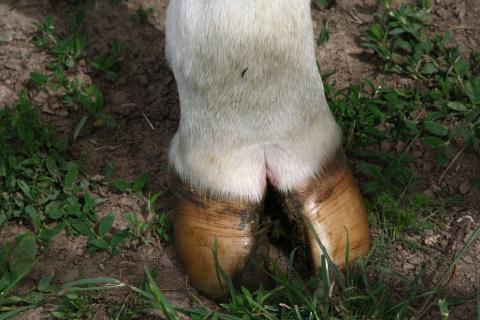What Do You Mean, "No Feet, No Meat"?

We just wrapped up a great small ruminant hoof trimming workshop; you may have seen it circulating around our NH agriculture networks. Participants left this workshop with a good grasp of the basics of hoof care, but more importantly, they left with the confidence to trim their own animal’s feet. I recently wrote an article called, “Healthy Hooves”, to key into why hoof care is so important for animals like sheep and goats. Consequently it should be no surprise that hoof care is important for all large livestock species.
As a colleague of mine says, “No feet, no meat”. It’s simple: if your livestock don’t have good feet, you can expect a drop in weight and overall productivity. Overgrown hooves make walking very painful for animals, can lead to ligament, joint, and infection issues, and make competing for feed difficult. As a result, this may cause your animals to move around less and not eat as much. Having a good hoof care and trimming program in place will help prevent chronic hoof issues, high costs per animal, and animal losses.
Since trimming and cleaning feet can be an intensive job, it is good practice to check in on them whenever you plan to doctor or handle animals. This way you keep on top of potential hoof issues without having to handle livestock an additional time. As a rule of thumb, cattle typically need to be trimmed once or twice a year while sheep and goats could need trimming as frequently as every eight weeks. Many factors affect the rate of hoof growth and how often you trim your animal’s feet, which makes it important to know the conditions in which you are raising them. Here are some of the top factors that impact hoof growth and some tips to help prevent hoof infection and lameness.
Environment
Mud season is around the corner, which means wet ground and wet feet. Strive to keep them dry! Bacteria thrive in wet conditions and most hoof problems can be easily avoided and managed by keeping your animal’s feet dry. In addition, depending on the environment your animals live in, it will impact how often you may need to trim or inspect feet. Livestock that are out on rocky or dry pastures may not require as much foot care as livestock on lush green pastures in high rainfall climates. Livestock on concrete may need more frequent attention since cement is much harder on a misshapen hoof.
If you do find livestock with issues such as foot rot, be sure to immediately separate them from the rest of the herd or flock. Some hoof infections are extremely contagious and can be difficult to eliminate once they infect the herd. That being said, these bacteria can live in the soil for long periods of time. So, if you find yourself on a neighbor or friend’s farm it wouldn’t be a bad idea to disinfect your shoes to prevent introduction of these pesky bacteria into your herd or flock.
Nutrition
Making sure your animals receive the proper diet for their stage of production will aid in maintaining good hoof health and strength. However, the richer the diet, the more frequently you may have to trim hooves. In some cases, especially when diets are high in sugars, you can run into hoof issues such as laminitis. Limiting those fresh spring forages may be necessary for some species, especially if they are not accustomed to that diet. Although laminitis is not as common in some species compared to others, it’s still good to be aware of diet changes and how that can impact the growth rate of the hoof.
Genetics
Some livestock are just put together better than others, and some are predisposed to chronic hoof diseases and lameness. This should be taken into consideration when breeding livestock and selecting a sire or keeping a dam. It is common practice to cull animals that often struggle with lameness. Although this may not always be viable if you have a small operation, it all depends on how much time and money you can afford to invest in treatment.
Whether for meat or not, feet are the foundation of all livestock. By implementing regular hoof checks and trimming, you will be able to catch most issues early and administer the proper treatment to prevent further outbreak or permanent damage. That’s not to say you’ll never have hoof issues, but it sure beats leaving it to chance!
For even more detailed information Hoof Anatomy, Care, and Management in Livestock out of Purdue University gives a great overview of hoof health care and maintenance. If you have any questions, don’t hesitate to reach out to our Dairy, Livestock, and Forage Crops team.